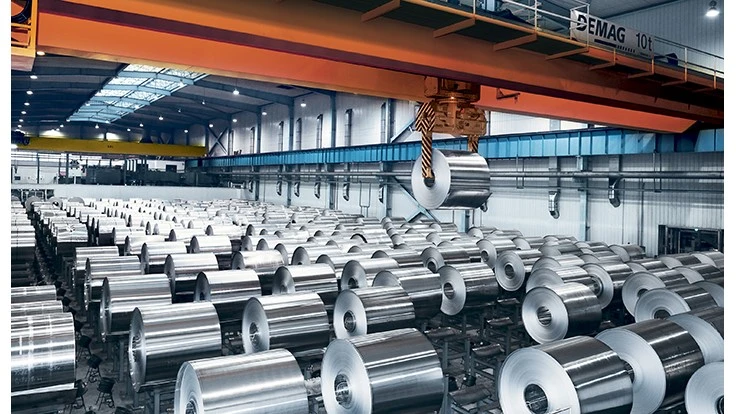
Granges

Two events have served as the catalyst for improved U.S. rolling margins and have spurred numerous investments in capacity. First came the U.S. anti-dumping and countervailing duty investigations on Chinese foil and common alloy products, which devastated such trade between the two countries. In the aftermath of the Section 232 (national security) and Section 301 (unjustified, unreasonable or discriminatory trade actions) investigations, which led to tariffs on Chinese goods, China retaliated by slapping a 50 percent import duty on U.S. aluminum scrap, again collapsing such trade. The dumping cases brought life to a U.S. rolling sector that had been struggling for years as rock- bottom Chinese prices compressed domestic margins. The duty on U.S. scrap imports left massive amounts of scrap in the U.S. market, pushing prices to historically low levels.
When you cut off imports from the largest producing country in the world, the market is sure to go through a state of shock. Although imports have seemingly been replaced, it required more than 10 countries to step in to fill the China void. Diversification is one thing, but managing multiple overseas supply chains can become a headache. All else being equal, domestic-made product is certainly more desirable given its proximity. With scrap offering a significant competitive advantage to U.S. rollers, perhaps now is the time for additional investments in rolling capacity to capture margins not seen in many years.
Filling the void
Nearly 12-months removed from the implementation of preliminary countervailing duty (CVD) and anti-dumping duty (AD) on Chinese common alloy sheet, the U.S. market has come full circle. The initial thought of losing 38 percent of total U.S. common alloy imports in one fell swoop sent shock waves through the industry. This prompted panicked buying and overcommitment on behalf of importers and foreign mills. As foreign mills overcommitted, delayed shipments began to pile up. Importers were forced to scour the globe in search of supply that would meet nearby requirements. Such holes continued to be plugged throughout the remainder of 2018, while foreign mills underperformed on delivery commitments, with some material arriving up to four to five months late.
2019 started off with a bang, with January imports of ex-China common alloy sheet posting a record high of nearly 88,000 metric tons. February imports dipped slightly but still posted the second highest monthly figure on record. A wave of late deliveries seemingly hit the U.S. in March as such imports nearly reached 98,000 metric tons. While the import faucet ran full bore, availability at various U.S. mills began to open up for a variety of reasons, including restarts, debottlenecking and equipment optimization. And now here we are; a market once on the verge of a supply shortage is in the midst of destocking that could last all of 2019.
Domestic mills, service centers and master distributors alike all report that common alloy standards are in massive oversupply. Service centers also have reported having inventory that is two-to-three-months higher than desired and that declaring contract minimums on volume or even passing on certain months is a likely scenario. This is not a reflection of weakness in underlying demand; it is rather a clear indication of being overwhelmed with incoming shipments that are severely late.
As destocking plays out over the next few months, the one factor that could swing the market back into a tighter supply situation is interest (or lack thereof) from abroad.
As destocking plays out over the next few months, the one factor that could swing the market back into a tighter supply situation is interest (or lack thereof) from abroad. Total U.S. common alloy imports through March are up only 6,500 metric tons, but first-quarter 2018 shipments are skewed by record Chinese imports ahead of the dumping duties. However, at the current average pace of 88,000 metric tons of ex-China common alloy imports per month, the U.S. is on pace to import an additional 283,000 metric tons than it did just a year ago. Massive increases have been seen in 2019 imports from Oman, Indonesia, Taiwan and other nations, but a large driver of the gains could be a matter of timing.
But what happens when prices fall? Import prices have taken a plunge since the beginning of the year, which could result in foreign mills shifting focus from the U.S. to other markets. Nonetheless, with the market flush with inventory, it’s becoming crystal clear that imports will see a dip in the coming months.
Broadened scope of Section 301 tariffs
In addition to the expected impacts of broader Section 301 tariffs on U.S. imports of can stock, which was discussed at length in CRU’s “Aluminum Rolled Products Market Outlook,” imports of aluminum plate and foil containers are likely to suffer. Although plate was not part of the scope associated with the AD/CVD investigation on Chinese common alloy, aluminum plate under HTS (Harmonized Tariff Schedule) code 7606.12.3030 (this would also capture reroll/hot band greater than 6.3 millimeters thick) is included in the newly proposed list of products to be subject to the 25 percent Section 301 tariffs.U.S. imports of aluminum plate from China have increased significantly throughout the past five years, rising from just less than 5,000 tons in 2013 to more than 40,000 tons in 2018. Imports are up an additional 9 percent through March of this year, though it’s unclear whether Chinese exporters would be able to absorb the 25 percent duty. If not, U.S. consumers would be left with the option of paying 25 percent more for Chinese plate or switching sources to domestic or other import suppliers, both of which are currently higher in price.
Another product on the list is aluminum foil containers under HTS code 7615.10.7125. This is a relatively new customs code that was implemented to monitor U.S. foil container imports in the wake of dumping duties being applied on Chinese foil imports. The code was first used in 2017, and customs data show a 44 percent year-over-year increase in foil container imports in 2018, and such imports are up a staggering 1,000 percent year to date through March. It’s unclear whether the 25 percent import duty would be enough to put a halt to the trade or if it would result in an increase in domestic foil container production.
Scrap prices could slide
Late last year, China’s Ministry of Ecology and Environment launched a new policy that became effective July 1, essentially banning the import of aluminum scrap under HTS code 7602.00.0090. In advance of that date, the rush to get aluminum scrap into the country seemingly started as far back as April. Chinese customs data indicate that imports of aluminum scrap jumped 22 percent in April, posting the highest monthly volume in more than a year. Despite the large gain in April, year-to-date scrap imports are off 22 percent, with imports from the U.S., China’s largest source of imported scrap, down by nearly 40,000 tons.
Although an import quota application process is associated with the country’s new policy, Chinese scrap imports are sure to decrease going forward. This will hit hard in markets such as the United States, which is already facing considerable pressure across the entire scrap supply chain. Aluminum scrap prices are at or below historical low levels, with further declines being seen over the past few weeks leading up to the impending ban.
Ripe for investment?
Rolling mills in the United States have made six investment announcements since September 2017, which came on the heels of the two anti-dumping cases. These include the expansion by Granges at its Huntingdon, Tennessee, mill and the restart of its Newport, Arkansas, mill. Also, on the list is the $255 million expansion of the JW Aluminum mill in Mt. Holly, South Carolina, and the investments by Arconic in Texarkana, Texas, (which was then sold to Ta Chen International Inc.) and in Knoxville, Tennessee. Each of these investments is set to address the shortfall of foil and common alloy sheet capacity in the U.S. market.
Additionally, such investments will benefit from record scrap spreads, which will support lower cost production of aluminum rolled products. According to CRU analysis derived from our aluminum Rolling Cost Service, U.S. 5xxx roller conversion costs over ingot (CCOI) plunged 14 percent in 2018 versus an increase of nearly 9 percent for European rollers, with more than two-thirds of U.S. movement because of lower scrap costs. Even so, the level of future investments will depend heavily on each firm’s view on whether the change in the scrap market is structural or a blip on the radar.

Explore the August 2019 Issue
Check out more from this issue and find your next story to read.
Latest from Recycling Today
- BMW Group, Encory launch 'direct recycling’ of batteries
- Loom Carbon, RTI International partner to scale textile recycling technology
- Goodwill Industries of West Michigan, American Glass Mosaics partner to divert glass from landfill
- CARI forms federal advocacy partnership
- Monthly packaging papers shipments down in November
- STEEL Act aims to enhance trade enforcement to prevent dumping of steel in the US
- San Francisco schools introduce compostable lunch trays
- Aduro graduates from Shell GameChanger program





